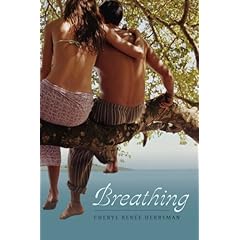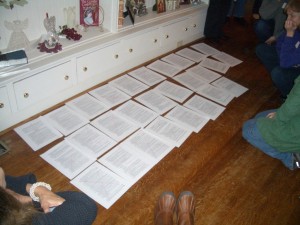new posts in all blogs
Viewing: Blog Posts Tagged with: How to Write, Most Recent at Top [Help]
Results 126 - 145 of 145
How to use this Page
You are viewing the most recent posts tagged with the words: How to Write in the JacketFlap blog reader. What is a tag? Think of a tag as a keyword or category label. Tags can both help you find posts on JacketFlap.com as well as provide an easy way for you to "remember" and classify posts for later recall. Try adding a tag yourself by clicking "Add a tag" below a post's header. Scroll down through the list of Recent Posts in the left column and click on a post title that sounds interesting. You can view all posts from a specific blog by clicking the Blog name in the right column, or you can click a 'More Posts from this Blog' link in any individual post.
Today, I get to revise.
I will . . .
- . . . rewrite the opening of a picture book ten different ways. I make my freshman composition students rewrite their openings three ways and always, the later tries are better. This picture book needs that kind of work to get past the cliches for the opening.

- . . . rethink a post for next week on plots. It’s an overview of the methods of plotting,a thoughtful piece that surveys the many books on the topic and makes some generalizations. It needs some filling in and some links and re-thinking to make sure the logic works.
- . . . reread a couple chapter of my novel. Re-reading is the #1 revision activity. Before you can revise, you must re-read. So, I’ll read and think and be ready to make changes next week.
A guest post I’d love to see: How to Write a Kissing Scene in a Romance Novel
Related posts:
- 3 Ways to Salvage a Scene
- Scene Box Text
- Scene Cuts

In July, I’ll open enrollment for an Online Picture Book course.
The online study class will include:
- 36 lessons
- Forum for questions and discussion
- One critique of a picture book manuscript AND a second critique of the revision of that same manuscript
- Self-paced
- 90-day access to Lessons and Forum
Picture Book Course Lessons
-
Picture Book Basics - 8 lessons
This section covers the basics of picture books: number of pages, word count, audience, setting, characters, words, messages, morals, themes, voice and more.
-
Picture Book Genres - 8 lessons
If you want to write a specific type of picture book, you’ll find tips here for rhyming text, poetry collections, picture book mystery, picture book biography, creative non-fiction picture book, and the ABC picture book.
-
How to Write a Picture Book - 15 lessons
Once you understand the basic structure of a picture book, it’s time to choose a topic and write the first draft. Special techniques for editing a picture book manuscript are also covered.
-
How to Submit a Picture Book - 5 lessons
Writing all done? Learn the biggest mistake people make when submitting to a publisher. How do you find the name of an editor? What about self-publishing?
Look for more information next week!
Post from: Revision Notes
Revise Your Novel!
Copyright 2009. Darcy Pattison. All Rights Reserved.
Related posts:
- 30 Days to a Stronger Picture Book
- How to Write a Poetry Collection Picture Book
- How to Write a Rhyming Picture Book


By:
Darcy Pattison,
on 6/25/2009
Blog:
Darcy Pattison's Revision Notes
(
Login to Add to MyJacketFlap)
JacketFlap tags:
author,
authors,
J.T. Dutton,
YA,
Stranded,
revise,
submit,
teen novel,
write a novel,
debut,
how to write,
Freaked,
Add a tag
Introduced first in 2007, authors debuting children’s books have formed a cooperative effort to market their novels. Last year, I featured many of the stories of how the 2k8 Novels Were Revised. This is part of the ongoing stories from the Class of 2k9 authors and how they went about revising their novels.
After yesterday’s posting about when to stop revising and send in a story, J.T. Dutton’s story seemed especially appropriate. Darcy

Freaked: A Revision Story
Guest Post
by J.T. Dutton
My first book, Freaked, leapt into the world three months ago. Since then, I’ve been trying to form ideas for a short blog on revision. I’ve seized on some good thoughts for the discussion, stuff I teach in my Composition classes, ways to revise to improve sentences or arguments through better examples. I am an intense devotee of the school of write and rewrite. “Nothing is so smooth it can’t be smoother” is one of my mantras.
But when I have to talk about the revising I did on Freaked, I feel shy. I read a lot and I can think of fifty or hundred novels that I see as perfect—every sentence, word, and scene. I’d like to be a “perfect” writer too, but the fact is, I’m not. I get muddled. I have reread Freaked at least three times since it came into print, each time cringing at the number of things I would change now that I’m older and wiser. This is after revising it hundreds of times over twelve years, with the last pass conducted by some of the smartest people in the writing business—the editors and copy editors at HarperCollins.
Surgeons Don’t Get “Do Overs”
My Dad reminded me recently, when I was expressing angst about my second book, Stranded, of a quote from Albert Einstein, “perfection is the enemy of good.” My Dad is a retired surgeon. In his field, he didn’t get do-overs. He had to believe in his skills, be courageous about them. He is always stopping to offer assistance at road-side accidents. He volunteers for an ambulance service and a local fire department despite the fact that he faces liability issues as the most prepared person on the scene if something goes wrong. (This is why some doctor’s don’t stop for emergencies.)
Dad has made it a lifetime practice to do what he can, when he can. He even “vacations” every couple of years at hospital in Haiti.
Revision is a great thing, but for people like me, it can lead to obsession and excuses not to share my work. At a certain point, I have to take my dad’s advice and admit that I can’t tuck every thread, that I’m flawed, that I make mistakes, but it’s better to offer the world what skills I have than to offer it nothing at all. In this way, I guess, the writing can be interesting, individual, and courageous, rather than perfect.
A pretty worthy goal.
Thanks Dad. You are my hero.
Post from: Revision Notes
Revise Your Novel!
Copyright 2009. Darcy Pattison. All Rights Reserved.
Related posts:
- Scott Franson’s Doodles


By:
Darcy Pattison,
on 6/24/2009
Blog:
Darcy Pattison's Revision Notes
(
Login to Add to MyJacketFlap)
JacketFlap tags:
revision,
critique group,
revise,
rewrite,
how to write,
novel revision,
cooling off,
get it right,
novel,
Add a tag
How Many Times Do you Revise?
When do novel or picture book revisions ever end? I’m always a new person, with a bit more knowledge and a bit more life under my belt. I could always make changes to the story. When do you know it’s time to submit your baby?
- My Best. When I’ve done everything I can right now. I try to revise as many times as necessary to get it right. If I’m happy with the story as it is, and I can’t think of anything else to try. And when I do try, it seems to mess it up, then I quit. For me, there’s also an emphasis on RIGHT NOW. Ten years from now, I’d do the story different, but RIGHT NOW (which is the only time we really have), I’ve done my best.
- Cool off. When I’ve let it sit for a while and still can’t figure out anything to do. Now this? I’m not so good at letting it sit. I want it out and accepted and published! But rejections have forced me to get better about letting a mss cool off. Time sometimes shows you what you couldn’t see before and you’ll know exactly where to revise. It might even, if you’re lucky, give you the right approach to improve the mss.
- Critique Group. When my critique group agrees with me. Ha! That doesn’t happen often enough. Sometimes critique groups make me feel like I’m back in junior high gossiping. As my son says, I don’t like all the drama. BUT, for the sake of my mss, I not only put up with it, but I encourage it. I need it. After a gossip session, though, I go away and consider and process and then approach a revision my way. Sometimes, it incorporates ideas from others, but in a different way or with my own twist. If I’m wise, though, I wait until my critique group likes the novel or picture book mss and then I send it out.
- Never. Some old novels and picture book mss are still in my file drawer. They need massive rewrites, I know. But for various reasons, they’ll never get what they deserve: the impulse for the story is gone, the story isn’t marketable today, I’m bored with the characters/voice/setting/plot/whatever. OK, I’ll admit it. Some sit because some critiquer made a remark that stopped me cold. Some sit because I don’t believe myself capable of doing the story justice. Some sit because, well, just because. Not all stories are meant to be shared with the world.
Be brave! Submit.

Post from: Revision Notes
Revise Your Novel!
Copyright 2009. Darcy Pattison. All Rights Reserved.
Related posts:
- Revisions Take Time
- Critique Groups
- Test Submissions


By:
Darcy Pattison,
on 6/19/2009
Blog:
Darcy Pattison's Revision Notes
(
Login to Add to MyJacketFlap)
JacketFlap tags:
book,
picture books,
critique,
audience,
revise,
children's picture book,
how to write,
chef,
re-write,
Add a tag
I’m writing a picture book that I know should work. But it’s not.
Consider the Picture Book Audience

Part of the problem with this story is that it’s set in a commercial kitchen and I have a kid who wants to cook. Critiquers tell me that the writing is great, the kid is great, but they wonder about that kid in a commercial kitchen.
Wouldn’t it violate child labor laws?
Wouldn’t the kid be in danger of getting burned?
Would a kid even WANT to be a cook? Why?
How old is this kid anyway?
Why is the kid even in this restaurant, so he gets hooked on cooking? Maybe, it’s his uncle’s restaurant and his parents work and he has to go over there after school and study.
ARGH! No!
Obviously, the adult audience for this story doesn’t connect. What about the kid audience?
At nine or ten, I was baking birthday cakes — from scratch — for my six brothers and sisters. One of the few dissenters in the group of critiquers says that her kids LOVE to make her coffee (Obviously, she lives in the great NW.) It just seems natural to me that a kid would want to cook! I’m convinced the story will work, if I can get around the adult objections.
And I do understand the objections. And I will address the objections. But it will mean starting from scratch and reconsidering both audiences for picture books, the adult and the child.
Research, then Revise
I decided to research. I’ve read through How I Learned to Cook, edited by Kimberly Witherspoon and Peter Meehan. This fascinating book is first-person accounts from some of the world’s greatest chefs on how they fell in love with cooking as a way of life. 
Many of the accounts are about a chef’s young adult years, or about some mistake s/he made during chef school or at a first job. But a couple were about falling in love with food and cooking at an early age. I’m also doing free-writes about why I liked cooking as a nine year old. And I’m reaffirming what is the heart of the story for me, remembering why I wanted to write this story.
A new draft will come. And it will be better.
Post from: Revision Notes
Revise Your Novel!
Copyright 2009. Darcy Pattison. All Rights Reserved.
Related posts:
- The Dual Audience for Picture Books
- Audience
- Audience

Transitions: Filling in the Time Line
I’m at a tricky place in my revision where I need a good transition. There’s a time gap. Certain events need to take place in late October and November, but I’m at about the 4th of July on the story’s time line. I need to get on with the story quickly, but it’s difficult. As it’s set up, my MC is starting middle school this fall, and that should be a big event in his life. But it’s NOT a major event, necessarily, in the story as currently told.
Yes, this is about a character, so he can be distracted for a while by this new school, but I don’t want to lose track of the events in October/November.
Create a mini-subplot that spans a couple chapters. I could think of July-October as a couple chapters of a mini-subplot. Adventure novels often do when there’s a chase sequence that spans several chapters. When the chase ends (someone is caught or someone gets away), the story returns to the main story.
Bridging events. I could think of this as needing bridging conflict, events that cause my character trouble that relates more or less to the main conflict. In this case, the events wouldn’t necessarily be a complete subplot. It could include scenes from several subplots, or it could be a small digression that shows backstory,or puts my character in a new light.
I don’t want filler material here, though. Either way, everything needs to be necessary to the story. That’s the trick! Finding bridging conflict or a mini-subplot to fill the time, but making sure it’s necessary to the story. Again, it won’t do, just to have a summary paragraph getting him to October. Going into middle school is simply too big a life event to summarize away.
Any other ways you handle major transitions or fill in gaps in your timelines?
Post from: Revision Notes
Revise Your Novel!
Copyright 2009. Darcy Pattison. All Rights Reserved.
Related posts:
- Choosing subplots
- Powerful Endings
- Big Scenes


By:
Darcy Pattison,
on 6/15/2009
Blog:
Darcy Pattison's Revision Notes
(
Login to Add to MyJacketFlap)
JacketFlap tags:
word count,
how to write,
write a novel,
page count,
finish a chapter,
finish an act,
confidence,
challenges,
revision,
revise,
Add a tag
Last week, I asked how you measure the progress of revising your novel, or of a writing session. Here’s the results:
Word Count and Page Count Indicate Progress
Word Count edges out Page Count by one vote. It seems the ease of counting words with word processors has made Word Count one of the easiest statistics by which to measure progress.

39,704 Words!
However, Page Count was only one vote behind.
Either way, it seems that we like those numbers! We can graph it, brag it, and soothe our writing beast with numbers.
Other Benchmarks of Progress
However, the other benchmarks of progress also got votes: finishing a chapter or an act, and the amount of time spent. It makes sense that not everyone does it the same way. Some write fast, others slow, so a time limit can easily work. I know that when I had four children underfoot, fifteen minutes a day was success!
Setting and Finishing Goals
Barbara Seuling says that she tries to meet the challenge of whatever faces her in a writing session and if she does that successfully, then she’s made progress. This gets away from the numbers and focuses more on the process and the content - a valuable approach.
Casey points out the obvious: we only worry about measuring progress when there’s a pause in the progress.
I think this is partly about the rhythms of the day, the rhythms of the work. But it could also be places/times when you get unexpectedly stuck! Then, we need to measure our progress to remind ourselves that we are making progress. Usually, for me, that’s why I stop and evaluate my progress: to maintain my confidence that I can continue to make progress.
Post from: Revision Notes
Revise Your Novel!
Copyright 2009. Darcy Pattison. All Rights Reserved.
Related posts:
- Measuring Progress
- My Current Works in Progress
- Writing rhythms

Re-Reading: The Basic Revision Strategy
I’m always amazed at how much the revision process depends on re-reading what you wrote.
It’s an obvious statement, of course. Yet, when I ask people about their revision process, re-reading is seldom mentioned. It’s one of those assumed things.
Suggestions for Re-reading to Re-envision

- Re-read an entire section, not just half a page. One editor cautioned against re-reading just half a page, because you don’t get a sense of how the revision flows with the rest of the story. It’s easy to repeat a word or phrase, to change tone, or to get slightly off-voice (like a singer gets off-key). Take it from the top of the novel or the top of the chapter; for picture books under 500 words, read the whole thing again.
- Single space the mss and print it out. This often helps me to see and hear the mss differently. Play with different fonts and print it out. Do you have a character who is feminine and delicate? Print her chapter in a script font; or, to contrast, print it in a harsh, upright font.
- Read out loud. OK. I mutter out loud. My husband is self-employed and we own an office building, so I have an office there myself. If I read out loud, it would bother others. So, I mutter out loud. Or, I put on earphones and use a software program that reads it out loud to me. (Actually, this is a good reminder: I need to use the earphones/read to me option more!) Or, I go home and read it out loud. Or, go to a park. Muttering isn’t as good as reading aloud, because you don’t get the real flow of the novel or picture book.
Someone once asked me how many times I had read through a novel. Who knows? More times than I can count, I’ve read every word. It’s the basis of all good revisions.
Post from: Revision Notes
Revise Your Novel!
Copyright 2009. Darcy Pattison. All Rights Reserved.
Related posts:
- 5 Writing Tasks for Off Days
- current stories
- Paper v. Digital Revision


By:
Darcy Pattison,
on 6/9/2009
Blog:
Darcy Pattison's Revision Notes
(
Login to Add to MyJacketFlap)
JacketFlap tags:
novel submission,
marketing,
feedback,
literary agent,
critique group,
critique,
Darcy Pattison,
contract,
revise,
how to write,
write a novel,
Add a tag
Submit, Then Revise
At our spring conference, Jen Rofe, literary agent at Andrea Brown Literary spoke about sending out manuscripts.
The one thing that surprised me was her attitude toward submission and revision. Rofe said she usually sends out a mss to about five editors. Then, depending on the feedback, she’ll often ask the writer to revise. She considers those “test submissions.”
Re-reading some of Writing the Breakout Novel Workbook by Donald Maass, I noticed the same thing. He said that Parnall Hall had to revise a mystery:
A test round of submissions suggested that the points of view in A Clue for the Puzzle Lady were improperly weighted. Hall revised, and the second round hit the jackpot. p. 47
Interesting. If literary agents regularly use this approach of test submissions then revision, it’s something to think about.

THE CRITICAL EYE
Next time you send out your children’s picture book manuscript or your novel manuscript, target five publishers. If you get feedback, especially if it’s consistent in what it says, then revise before you send to five other editors.
Individual Critiques v. Group Critique
What if you don’t get personal letters from editors? I recently sent a picture book manuscript to about five different people and, without consultation with each other, four of the five mentioned a few items that needed work. Now, personally, I loved the fifth person’s comments! If she was an acquiring editor and bought the mss as is, no problem. But she’s not.
So, I have an overwhelmingly consistent opinion that something needs work.
Usually, I send to a critique group and everyone there sees the mss and it’s a group discussion. That always feels like a single opinion to me; here, I sent it privately and it’s five opinions. If those five had been in a group, the discussion may have progressed the same, but I would not be as likely to pay attention.
Will I always ask for separate critiques now? No. The group discussions are valuable. But I’m definitely adding this variation to my arsenal of revision strategies.
And yes, I’m working on revising the picture book manuscript, trying to do at least some of what these individuals asked for, while secretly hoping to find an editor who agreed with the other person!
Post from: Revision Notes
Revise Your Novel!
Copyright 2009. Darcy Pattison. All Rights Reserved.
Related posts:
- Are You Still Not Tracking Submissions?
- Are you Still Submitting Before Revising?
- Q&A: How Do I Find an Editor’s Name for Submission?


By:
Darcy Pattison,
on 5/22/2009
Blog:
Darcy Pattison's Revision Notes
(
Login to Add to MyJacketFlap)
JacketFlap tags:
preschool book,
picture books,
children's literature,
Darcy Pattison,
revise,
copyedit,
children's picture book,
edit,
how to write,
line edit,
Add a tag
Simplify Your Picture Book Story
I’m currently revising a picture book and my major goal is to simplify the story.

Simple Steps to Revision
- Why simplify the story? At 1200 words, the picture book text is way too long. I needed to cut it about in half. Why? Sue Edwards has just been reading 50 picture books in a short amount of time - something you should do at least once a year if you write picture books - and she reports that “. . .short sells. I ran into very few longer books.” Simplified = Sales. Good enough reason.
- Omit Major Character. In fact, this version of the story had already simplified by leaving out a major character. It meant a total reworking of the story, but it flowed much smoother.
- Cut the conflict in half and expand what’s left. Given that 600 words is a worthy goal, what could I do? I took the first half of the story and expanded it into the whole story, thus simplifying it by leaving out the conflict in the last half of the original. It sounds drastic and it was. But after it was done. I wondered how I could ever have thought we needed that last half.
- Planning for interactivity. In the next revision, I plan to strengthen the interactivity of the story. I already have one section where kids can anticipate and chime in. I”m looking for a couple more places.
- Planning for stronger language. The cuts I’ve done so far are playing up the fun language of the story. But I think it needs more tightening, so the fun phrases will shine.
- Planning for unique characters. A friend reminded me that my characters are too stereotypical. But with minor edits, I can remove the stereotypical references and leave the characters stronger.
- Planning to connect the beginning and end. The motivation at the beginning and the resolution at the end are still not matching up exactly. It’s close - but not right. I’m searching for alternative ways of setting it up. Because I like the new ending, which means the beginning has to set up that ending.
Not much to revise, huh? And people think writing a picture book is easy?
Post from: Revision Notes
Revise Your Novel!
Copyright 2009. Darcy Pattison. All Rights Reserved.
Related posts:
- Begin at the Beginning
- Picture Book 2
- Picture Book 3

Second Most Important Sales Tool: Flap Copy

Flap copy is the advertising copy on the inside covers of a book. According to a recent Publishing Trends article, it is the second most important selling point for books, especially fiction.
Yet, often, it is an editorial assistant who writes the copy.
In this interesting series of articles Publishing Trends reports on a case study of an FSG adult debut novel, Come Sunday by Isla Morley.
Some interesting conclusions:
- Character & Promo. For readers under 18, focus on character details and brief promotional statements or quotes. Don’t make them work hard to figure out what the book is about; “cut to the chase.”
- Catalog v. Flap Copy. FSG editor Sarah Crichton distinguishes between catalog copy and flap copy: “The catalogue copy has to appeal to potential reviewers and booksellers, whereas with the flap copy, this is your one chance to speak directly to the buyers and readers.”
- No Magic Formula. Peter Hildick-Smith, of the Codex Group who conducted the study said, its still hard to predict which copy will do better. “Part of that is the crucial interplay between title/cover and copy, and part of it is the fact that one person can’t perceive anothers’ intuitive response to a creative message.”
Post from: Revision Notes
Revise Your Novel!
Copyright 2009. Darcy Pattison. All Rights Reserved.
Related posts:
- Flap copy
- Harry Potter Flap Copy
- A Revision Case Study: Eleven by Lauren Myracle.


By:
Darcy Pattison,
on 5/12/2009
Blog:
Darcy Pattison's Revision Notes
(
Login to Add to MyJacketFlap)
JacketFlap tags:
editor,
author,
children's books,
links,
Arkansas,
writer,
scbwi,
literary agent,
speakers,
how to write,
Add a tag
The Arkansas SCBWI Conference is this weekend in Conway, AR.
Featured speakers are Anastasia Suen, Greenwillow editor Martha Mahilick, and agent Jennifer (Jaeger) Rofe, from the Andrea Brown Literary Agency.
Earlier, I linked to the websites and blogs of the speakers.
Full registration information is available on the Arkansas SCBWI website.
If you’re anywhere close, come join us!
Post from: Revision Notes
Revise Your Novel!
Copyright 2009. Darcy Pattison. All Rights Reserved.
Related posts:
- Voice Retreat
- Meet Literary Agent Michelle Andelman
- Meet Me

7 Children’s Picture Book Manuscripts in 7 Days

I’m taking the 7 in 7 picture book challenge.
Report on 7 in 7 for the first week of May, 2009
- May 7
- May 6. Historical Fiction. OK, here comes the rationalization for why I don’t have a good draft done. A couple years ago, a friend told me a tidbit of interesting history. She was writing about it, though, so it was off limits for me. But it’s stayed with me as — well, very interesting. Especially interesting for kids. Yesterday, when I was thinking of topics to write about, that historical teaser came back and I looked up something about it and of course, a footnote took me off on another tangent. Which I actually think is even more fascinating for kids.
In other words, I researched yesterday; I wound up with a very sketchy draft, if you could even call it a draft. In the end, it’ll be a good picture book, but the goal was supposed to be to write a draft. Well, maybe it’s a draft. I could call it that, right?
Note: This is a note of general frustration with writing 7 picture books in 7 days. I want to dig in and revise, which I do endlessly on picture books. Instead, I have to come up with a new draft! ARGH!
Actually, 7 days may be about right: only two more days to scribble out first drafts, and the rest of the year to revise.
- May 5: A Cumulative Story. After tossing out lots of ideas, I finally settled on a cumulative story much like This is the House that Jack Built. It’s an idea I had toyed with before and was fun to take it through all the stages.
- May 4: Delaware and Miriam. OK. This is getting hard! Picture books are short, yes, but that doesn’t mean they are easy to write. I’ve never written one in less than three days of intensive, obsessive work.
I did get a draft done last night. It has a beginning, a middle and an end. But it’s no where near fully explored, much less refined. Still, just to get a draft done, I was pleased.
I think the main problem is characterization. Why would this character do this? My problem is that I tend to write generic characters in my picture books and I’m really struggling to do more in such a short time frame.
- May 3: At the End of the Rainbow. I didn’t even start until 7 pm because I went to church, then did accounting. But I managed to finish a full draft of this story and am excited to see how it sounds after a couple days of cooling off. The title will change, but it’s a good working title. 1295 words. Yes, I’m writing long, but I can cut.
- May 2: ABC book. OK, so it’s one I had half-way started before and abandoned because I had blanks for about six letters. All I did today was fill in the rest of the letters, add more options to the letters I had and did general research and clean up. But I now have something for each letter. Yes, two or three are shaky. But it’s progress and I’m counting it.
- May 1: Violet Ivy’s Button Eyes. 1128 words.
Post from: Revision Notes
Revise Your Novel!
Copyright 2009. Darcy Pattison. All Rights Reserved.
Related posts:
- Picture book 1
- Picture Book 3
- Picture Book 2


By:
Darcy Pattison,
on 4/30/2009
Blog:
Darcy Pattison's Revision Notes
(
Login to Add to MyJacketFlap)
JacketFlap tags:
characters,
child,
baby,
suspense,
how to write,
tragedy,
write a novel,
symbolism,
jeopardy,
character's death,
death scene,
emotional depths,
fully characterized,
Add a tag
Does Your Story Need a Tragic Death?
A friend was talking to me about stories in which a child dies. he asked, “Is a child’s death in a novel just a cheap narrative device?”
Well, it depends.
- Depth of Characterization. How well do we know the character? Do we know and care for the child? Does the story involve the child and his/her hopes dreams in any way? If we care for a character, we’ll be more likely to be emotionally affected by the death; and it will seem more like a part of the story and not just a cheap narrative device.
- Minor v. Major characters. If a minor child character dies, a throw-away character, the audience won’t care much, unless you’ve given the character big eyes with long eyelashes. But even that bit of specificity in the middle of a scene might not make the reader care. Because it’s a kid, it may be worth some shock value, and killing a kid simply for shock value does count as a cheap narrative trick.
- Suffering, jeopardy, suspense. Has the character suffered or does this come out of nowhere? Orson Scott Card talks about jeopardy, putting a character into a position where there is danger, and suspense, holding back only what happens next. It may be enough to put a child in increasing jeopardy, where things are dangerous, but the character must still act. Or, it may be enough to built a suspenseful scene where we worry about what happens next. Some death scenes could be replaced with either of these and still be effective
- Symbolism of a child’s death. Does the death of a child represent the loss of innocence and faith in the future? Depends. How did you set up the symbolism of THIS child? I don’t think you can generalize here, because the language used to describe the child, the actions of the plot – these can all affect symbolism. To say that a child’s death always equals loss of innocence is too glib an answer.
- Author’s Tolerance for Death. When Leslie dies in Bridge to Terabithia, it’s tragic and awful; I didn’t feel like the author had tried to manipulate my feelings, it was just a horrible accident. But I once went to a conference where an author was talking about the death of a child when it occurs in a story. The author said she hated going to schools, where kids would inevitably ask, “Why did so-and-so have to die?”
Tired of the plaintive question, she decided to never write another story for kids in which a child died. She was in the process of writing a story where a baby was sick and in the hospital. With her decision made, she started working on the next chapter and wrote, “The baby opened her eyes.”
Was she protecting herself from the questions? Was she protecting her audience from the emotional depths to which stories can take a reader? Was she protecting the baby? I don’t know.
In the end, you have to decide where you and your stories will fall: will you allow tragedies, even to the point of death; or will you hold back to protect yourself, your readers and your characters? What does the story tell you to do?
Post from: Revision Notes
Revise Your Novel!
Copyright 2009. Darcy Pattison. All Rights Reserved.
No related posts.

Do you pay attention to your audience when you write, or do you write for yourself, an audience of one?
PW’s Shelf Talker Josie Leavitt has an interesting posting on when toddlers pick out their own books. Even as toddlers, boys and girls choose books differently. Both are passionate about the books they love and both love bright colors. But boys tend toward the blue, while girls go for pink and purple.


Mouse was Mad by Linda Urban and Duck! Rabbit! by Amy Krause Rosenthall are reported to be popular with both girls and boys. They are still bright and bold, but Mouse is mostly yellow and Duck is black on white.
Leavitt’s column discusses color, something out of the scope of most writers; yet, her basic ideas applies to all of us: we should consider our audience when we write. We should think of their developmental age, reading level, interests, culture, etc.
Do you consider your audience as you write your toddler booK?
As you write and revise your preschooler’s picture book?
As you write and revise your children’s picture book aimed at school-age kids?
As you write and revise your middle grade novel for those tweens?
As you write and revise your YA novel?
As you write and revise that article for your local newspaper?
As you write (and revise) your grocery list?
As you write the letter to your child’s teacher?
As you write your blog postings?
Post from: Revision Notes
Revise Your Novel!
Copyright 2009. Darcy Pattison. All Rights Reserved.
Related posts:
- Audience
- Audience Considerations
- A Real Audience


By:
Darcy Pattison,
on 4/22/2009
Blog:
Darcy Pattison's Revision Notes
(
Login to Add to MyJacketFlap)
JacketFlap tags:
editor,
Picture book,
revision,
manuscript,
critique,
revise,
attitude,
editorial letter,
children's picture book,
how to write,
Add a tag
Yesterday, I started brainstorming on revisions for a picture book. I got some editorial feedback in February when I saw the editor in NYC. But it’s been hard to approach this revision because when we talked, I disagreed with much of what the editor said.
Cooling Off Period Helps Me See Editor’s Wisdom
So, I put it aside for a while and when I went back with a more objective look, I could at least understand the editor’s position. That’s a good starting place. So, I opened the file, made a minor change and then saved it with a new title, “MssForThisEditor.” This way, I keep the original story intact and label this version as revised just to address one editor’s concerns.
Then, I attempted to throw away all my preconceived notions of what this story was and where it could and should go. I started jotting ideas, objections, words, imagery, rants against the suggested changes, rants against the rants, and generally preparing myself mentally to revise. I allowed a couple hours for this, then moved to a different task.
This morning, My Subconscious told me that it had been working on the problem overnight and had some ideas. Well. That was a surprise.
Good. My Conscious still likes the original better, but I’ll let ol’ Sub work a while today and see what happens.
Post from: Revision Notes
Revise Your Novel!
Copyright 2009. Darcy Pattison. All Rights Reserved.
Related posts:
- Revision Attitude: Cut Short That Pity Party
- 3 NaNoWriMo Tips to Make Revision Easier
- Stay Focused on Revision


By:
Darcy Pattison,
on 4/20/2009
Blog:
Darcy Pattison's Revision Notes
(
Login to Add to MyJacketFlap)
JacketFlap tags:
agent,
author,
novel,
authors,
revision,
psychology,
how to write,
write a novel,
2k9,
write a book,
Add a tag
Introduced first in 2007, authors debuting children’s books have formed a cooperative effort to market their novels. Last year, I featured many of the stories of how the 2k8 Novels Were Revised. This is part of the ongoing stories from the Class of 2k9 authors and how they went about revising their novels.

Will This Novel Revision Change My Vision of the Story?
by
Cheryl Renee Herbsman
Revision is such an interesting subject. In college and graduate school (in psychology) it was always something with which I struggled. Revision felt to me like I just had to change what the professor wanted me to change to please him/her. And as I did that, I found that the story or novel felt less and less my own.
Agents say, “Drop that character.” The first literary agency that expressed interest in my novel, Breathing, asked me to do a revision. They made a number of suggestions and I worked hard at incorporating the revisions I believed would make the book stronger (such as developing the character of Mama further). But they also wanted me to drop one of the key characters (DC) from the novel. And that was something I just couldn’t do. While they praised my work on the revision, they rejected the novel. This made me wonder if I was going to have to give up my vision for the book, but I pressed on.
Next agent loves novel, as is - and sells it! The next agent loved it as is and sent it out to publishing houses immediately. The book sold quickly, which was very exciting.
Editor requests revisions. When my editor sent a revision letter for my book, I became nervous. What would happen if I didn’t make every change? Would it be tolerated? I decided to hope for the best.
Will Herbsman’s vision of the novel stick? I made all the revisions I believed strengthened the novel (such as giving Savannah a summer job so she spent less time moping, revising the timeline for the program in the mountains so it made more sense, increasing Jackson’s passion for his painting). And I didn’t make the other changes in my book – the ones that just didn’t feel right to me on some gut level (such as removing Savannah’s visions or her saving Jackson from the train). And I sent it in. And . . .
. . . the editor loved it. And she told my agent how impressed she was that I stuck to my own vision of the story and didn’t make every change she suggested. That felt huge to me.
So what I learned with this first book is that it’s important to make changes, yes, but it’s also crucial to be the one holding the vision of the story that gave itself to you.
Post from: Revision Notes
Revise Your Novel!
Copyright 2009. Darcy Pattison. All Rights Reserved.
No related posts.


By:
Darcy Pattison,
on 3/6/2009
Blog:
Darcy Pattison's Revision Notes
(
Login to Add to MyJacketFlap)
JacketFlap tags:
revision,
retreat,
contracts,
revise,
how to write,
writing career,
write a novel,
negotiate,
shrunken manuscript,
Add a tag

Shrunken Manuscript at Illinois Novel Revision Retreat
Take Time to Revise
Jim Danielson, who attended last weekend’s Illinois retreat, has also posted a picture of a shrunken manuscript.
Here are other links for the Shrunken Manuscript technique:
Intensive feedback, like you get in a weekend retreat, can be overwhelming and after a while, I know I would tend to shut down and just nod and not understand what someone was saying. It’s important to take time later to rethink all the comments you wrote down.
Jim is planning to use the shrunken manuscript to check several issues in his story. Likewise, I know other participants are rereading their manuscripts and hearing the voices of their critique partners in their heads.
Revisions take time: time to give up something you clung to even though it wasn’t working, time to re-envision your story, time to work out the details of the changes needed, time to fall in love with your characters again, time to do the work needed.
Writing is a Business
 I also heard from a participant in last month’s Oklahoma picture book retreat. The last session there was about the career of writing. We discussed the realities of submission, contracts, and the fate of midlist books. I suggested the writers read, The Good Girl’s Guide to Negotiations. (Only two participants were men!)
I also heard from a participant in last month’s Oklahoma picture book retreat. The last session there was about the career of writing. We discussed the realities of submission, contracts, and the fate of midlist books. I suggested the writers read, The Good Girl’s Guide to Negotiations. (Only two participants were men!)
Too many times, I see women writers play tea party in negotiations, to their own detriment.
So - one writer wrote to say that an agent had given her a personal rejection letter. Not the first time this has happened. But it’s the first time the writer immediately sent a second manuscript, which addressed the concerns of the letter in fresh ways.
Yes! Stand up for yourself and your career! No one cares about it as much as you do and if you don’t push for acceptance of your stories, why should anyone else?

Stiff Competition for These Picture Book Topics
Dial editor, Liz Waniewski (ONE–es-key) spoke at the Arkansas SCBWI 2007 conference. For a couple months before the conference, she kept track of her slush pile picture book submissions by category. This resulted in my 2007 posting 12 Picture Book Topics to Avoid, one of the more popular posting in the 30 Days to a Stronger Picture Book series.
In December, 2008, I asked Liz if she might want to update the posting. She agreed and kept track of her submissions in January. The topics listed below are those which she sees over and over. She pointed out, “Just because I see these topics many times doesn’t mean you can’t write about it.” However, the competition is very stiff for picture books in these categories and your submission should really “stand out in today’s crowded marketplace.”
In comparing the 2007 and 2009 lists, you’ll see some overlap, such as grandparents. But there are new topics on the 2009 list, such as “going green.” Some differences, such as the predominance of holiday stories in 2007, may also result from the different times of the year the data was gathered. Be aware, also, that another editors list might vary widely. Still, knowing that many others writers are working on these topics, should make us either avoid them entirely, or take our manuscript to that next level.
2009 List of 10 Picture Book Topics to Avoid
- 2009 Repeated topics from 2007 list:
- Bedtime
- Cats and kittens (was pets in general in 2007)
- Visiting grandparents
- First Day of school
- Dealing with disabilities
- New for 2009 list:
- Monsters acting un-monster-like
- Going Green
- “I Love You” stories
- Boredom
- Baby Bird Learning to Fly
On 2007 List but not on 2009 list:
It would still be wise to check out the competition on these topics.
- Cleaning up your room
- Tooth fairy
- Christmas/Halloween
- “Hi! My name is. . . and I am (seven) years old!”
- New baby in the family
- Barnyard stories
- Personal hygiene




















